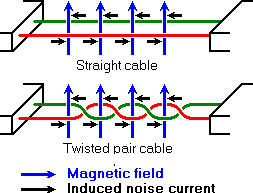RS422 serial information
- Introduction to RS422
- Differential balanced signals with RS422
- Electrical characteristics of RS422
- Network topology with RS422
Introduction to RS422
Serial communication methods to transfer information between equipment have been defined by standards for nearly half a century. The oldest and best known standard is RS232, a standard which defines the communication between DTE, data terminal equipment, and DCE, data communication equipment. The relatively short distances and low speed the RS232 serial interface can handle demanded for newer standards like RS422, RS423 and RS485. In this document, I will focus on the RS422 interface for serial balanced differential communications.
Differential balanced signals with RS422
Serial, balanced and differential are the keywords for the RS422 interface standard. Serial means, that the information is sent bit by bit on a single transmission line, just like with RS232. Balanced differential is what makes RS422 different from RS232. On RS232 interfaces, the signals are send on lines which share a common zero. With RS422, each signal line consists of two wires, preferably twisted to reduce noise. The voltage-difference between the two lines is an indication of the signal value, rather than the voltage-level. Looking at voltage differences with RS422 rather than levels eliminates a lot of noise induced by external sources and allows for higher data rates and cable lengths compared to RS232. You can see the differences in speed and cable length between RS422 and other commonly used serial interface standards like RS232, RS423 and RS485 in the interface comparison table.
Twisting the lines helps to reduce the noise. The noise currents induced by an external source are reversed in every twist. Instead of amplifying each other as in a straight line, the reversed noise currents reduce each others influence. The figure explains this in more detail.

Network topology with RS422
There are more differences between RS422 and RS232 than the maximum data speed and cable length. RS232 was specifically defined as an interface between computers, printers and terminals with modems. The modem would translate the communication signals to protocol usable for long distance communication, where long distance could also mean a device on the other side of the control room or building. RS422 allows the direct connection of intelligent devices, without the need of modems. Furthermore, where the RS232 line driver is only designed to serve one receiver, a RS422 line driver can serve up to ten receivers in parallel. This allows one central control unit to send commands in parallel to up to ten slave devices. Unfortunately, those slave devices cannot send information back over a shared interface line. RS422 allows a multi-drop network topology, rather than a multi-point network where all nodes are considered equal and every node has send and receive capabilities over the same line. If you need to build a multi-point communication network rather than multi-drop, RS485 is the right choice with a maximum of 32 parallel send and 32 receive units parallel on one communication channel.
|
No books are lost by lending
except those you particularly wanted to keep.
ATWOOD'S FOURTEENTH COROLLARY
|